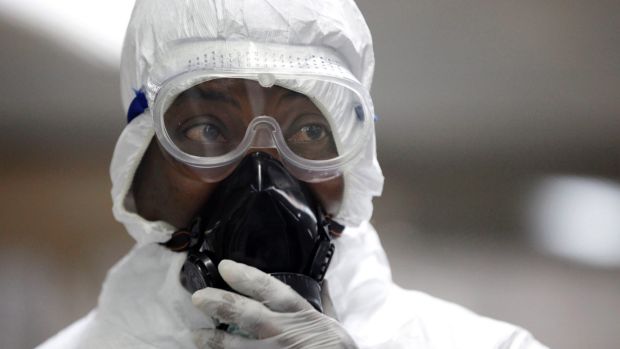West Africa’s Ebola outbreak remains “intense and widespread” in Sierra Leone, the World Health Organisation says, and officials in Mali are searching for hundreds of people who may have touched the body of an infected imam.
But how serious a threat is Ebola?
 A health official wearing a protective suit waits to screen passengers in Lagos, Nigeria.
A health official wearing a protective suit waits to screen passengers in Lagos, Nigeria.
The most recent count of fatalities, compiled by the WHO and released on November 19, puts the number of cases in West Africa at 15,145 and deaths at 5420.
What begins as a fever, sore throat and aches rapidly progresses to vomiting and diarrhoea. With the body’s immune system in chaos, blisters form under the skin, blood vessels burst and a patient succumbs to internal bleeding.
The world has seen two dozen outbreaks since Ebola was first identified in 1976, when it killed 280 people in the Democratic Republic of Congo and 151 in Sudan. But the current epidemic has killed more than all others combined.
It has also claimed more than the Severe Acute Respiratory Syndrome (SARS) that erupted in 2002, Asia’s bird flu scare in 2003 and the Middle East Respiratory syndrome (MERS) of 2012.
Nearly every fatal Ebola infection has occurred in the West African countries of Guinea, Liberia and Sierra Leone. Eight people in Nigeria, five in Mali and one in the US also have died.
In a space about half the size of NSW, the number is significant, particularly given the virulence of Ebola. And it is the possibility of contagion that has worried the international community most.
The mortality rate – the deadliness – of Ebola can be as high as 90 per cent, although this varies by outbreak, strain and access to medical care. Health officials put the mortality rate for the latest outbreak at 50 per cent.
Historically, this makes Ebola a proficient killer. The little-known Plague of Justinian tore through the Roman Empire in the 6th century, taking an estimated 12 per cent of the world’s population.
And by some estimates, bubonic plague – the famed Black Death that ravaged Europe in the 14th century – killed 80 per cent of those who contracted it, but such rates are rare in modern history – with one exception: HIV/AIDS.
To a large degree, medical science gets credit for identifying and inhibiting the spread of potential pandemics. It’s a far cry from the popular treatments of the mid-1300s, when plague victims were blooded with leeches, fed crushed emeralds and, perhaps least popular of all, bathed in urine.
So why are people so concerned about Ebola? It’s because the current outbreak is yet to be fully contained.
The best-case scenario projects the epidemic will end in late January. That, though, is believed to substantially under-report existing cases, in part because insufficient facilities exist to treat infected patients.
At one point, the CDC’s worst-case scenario estimated West Africa could amass 1.4 million cases within four months. That no longer holds true, but a revised estimated has not yet been released.
Which helps explain why Australia has committed $20 million to build a field hospital in Sierra Leone and why that has sparked debate about whether it is a sufficient response for a country of Australia’s size and stature.
